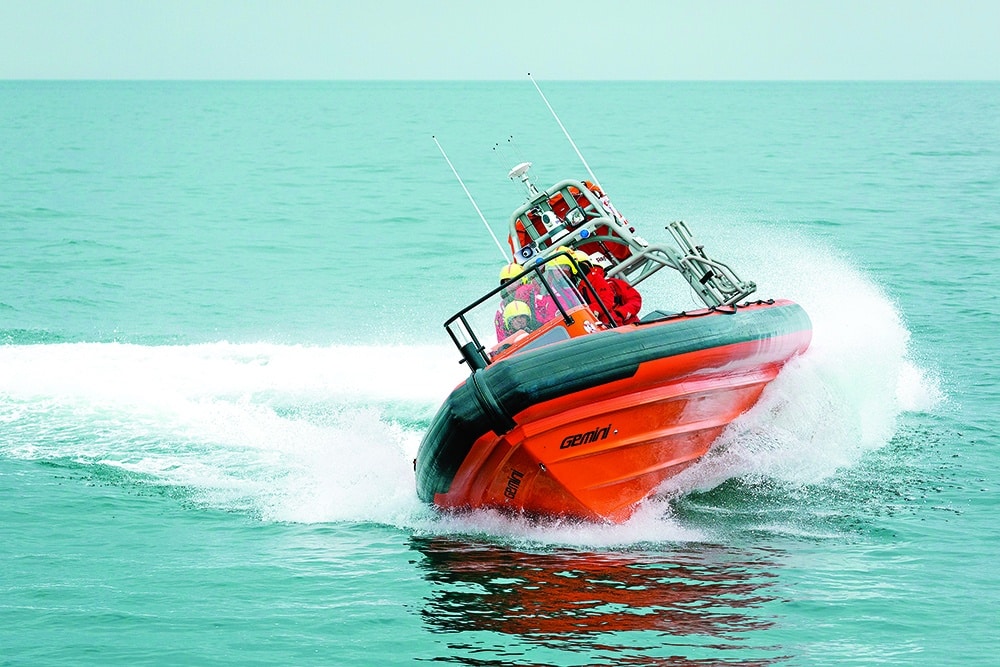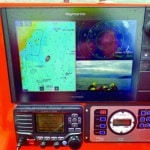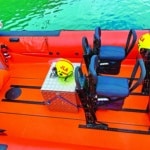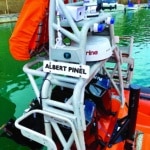Joe Mourant provides PBR with an exclusive ‘access all areas’ tour of the much-publicised Jersey Lifeboat Association’s new Gemini 880 lifeboat, Albert Pinel, before getting taken on a nail-biting exercise in harrowing conditions off the perilous Jersey coast.
Noirmont Point is a jagged rocky headland on Jersey’s south coast that is notorious locally for producing very strong seas. On the wrong day, particularly when the tide is running against wind, the confluence of swift currents swirling over the sharply rising seabed produces dramatic overfalls, which, as you can imagine, can be treacherous. When I joined a recent training exercise run by the Jersey Lifeboat Association (JLA), these were precisely the conditions that were in evidence as we bore down on the infamous headland.
I joined five JLA crewmembers aboard the organisation’s brand-new Gemini WR 880 inshore lifeboat Albert Pinel. This sizable RIB, bristling with cutting-edge gadgetry, is very unlike the seagoing leisure RIBs I skipper and instruct on as a profession from day to day. But before I discuss how she performed on the day of the exercise, allow me to take you on a little tour of some of the craft’s internal attributes.
Upon inspection
We’ll begin at the blunt end, in the stern, where there are several items of note. Of course, the vessel’s arch mast is not an aesthetic add-on, but rather a robustly fashioned construction designed for functional purpose. This feature not only supports the Raymarine Quantum 2 radome, a searchlight, multidirectional FLIR camera and blue emergency lights, but also a self-righting system. The latter is of the inflatable bag variety, a tried and trusted system, which benefits from being relatively lightweight and simple to deploy in the event of a capsize.
- Raymarine & Icom equipment – well-proven in SAR craft
- Note the Allsalt SHOXS shock mitigation set to adjustable tracking.
- The heavy duty stern arch and flying gear.
Also, in this section of the craft, the hinged reboarding ladder is likewise another valuable item. Capable of being unfolded at the arch mast, it allows either crew or able-bodied casualties to re-enter the craft without the need for being hauled up over the tubes or having a Jason’s Cradle deployed. Also located in the business end of the boat, a mammoth 500kg-rated towing post dominates the aft deck ahead of the transom well. This is a critical item in the Albert Pinel’s armoury as a large number of the vessels needing assistance represent breakdowns, and hence the ability to tow a disabled craft to safety is essential in these waters.
With her 3m beam, the Albert Pinel is a vessel of hefty proportions for her overall 880m length. But this affords the deck space required not only for ease of crew movement but also for casualty carrying. Her professionally spec’d Allsalt SHOXS shock mitigation seats, though serious items of hardware in their own right, are nonetheless compact in design and so don’t overly encroach on the valuable working deck space.
Stepping up to the helm, it’s clear that no space is wasted, and while there’s a lot of kit and equipment stowed or housed, in terms of the helm at least, the twin Mercury Verado 225hp set-up, with its associated throttle controls, remains familiar territory. The helm console’s ergonomics are spot on with a perfect set-up given to them, and the correspondence between throttle and wheel is just right. Likewise, the craft’s instrument cluster has been laid out with great thought and includes a 12in Raymarine Axiom multifunction display, which in turn is set to a tri-screen configuration of radar, chartplotter and FLIR camera. There’s also a secondary 9in Axiom display to further bolster data availability at the helm when running search patterns, etc. Only an integrated stopwatch, to execute sector searches, belies the vessel’s SAR purpose.
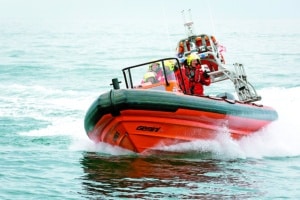
The Albert Pinel undertaking a ‘Vector Search’
Having had a reasonable degree of experience with Axiom radar sets myself, I particularly appreciated the instinctive nature of the display, which specifically detects the radar echo frequency shift returned by moving versus stationary targets. These are then allocated colour codes by the Quantum system to show moving targets and indicate whether they are getting closer (red) or moving away (green). This is very simple but also very confidence-inspiring, especially when out at night or in reduced visibility in busy waters and shipping lanes. But let’s move on to the matter of the craft’s all-important performance-related abilities and how these stood up under the realities of the exercise.
The Albert Pinel’s foredeck represents an invaluable working area where casualties can be assessed, items of gear assembled and made ready for use, the main anchor deployed, and from where airlifts can also be made and received. The relatively high gunwale provided by the large-diameter Hypalon tubes can be used to brace one’s legs against and in turn give a reasonable amount of on-board security in the fore section of the craft. Internally, the boat’s overall fit-out and design clearly benefits from the application of a great deal of working knowledge and first-hand experience.
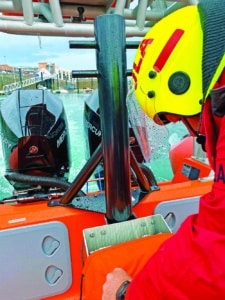
The Mercury outboards and sturdy transom
Out to the headland
Battling our way out from St Helier’s small roads into a head sea issuing from the south-west, I was pleased at how effective the SHOXS seating system proved to be. These were certainly the type of conditions I would have ordinarily taken on my legs aboard a RIB with standard jockey seating. With the SHOXS I found the posture it best suited was a combination of standing and sitting with extended but slightly bent legs. The seat system certainly showed its ability to absorb the punishment the seas were delivering, and its design meant I was able to take an element of the ride on my legs when required, which I liked. We were making a steady 15 knots at this point in our outward-bound passage, which represented the hull’s minimum planing speed when fully loaded.
After fighting our way west around Noirmont, we then commenced a veering-down exercise in Beauport Bay. This is an SAR technique used to afford the crew the opportunity to get within striking distance of a casualty who may be cut off by the tide on a rocky ledge or at the foot of cliffs. This procedure is achieved by dropping an anchor a suitable number of metres out from the casualty before engaging astern gear and allowing a crewman to gradually pay out the line until the vessel is close enough for the casualty to be grasped and safely brought aboard.
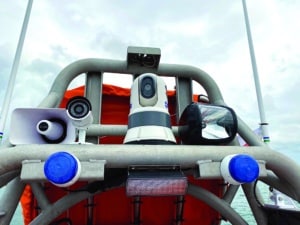
Search light and the FLIR
night time vision
Gemini in action
Each of the JLA crew took turns helming this exercise. The engine closest to the casualty quadrant was turned off and trimmed up out of the water (for the safety of the casualty and to keep it from striking the rocks), while the outside engine was held in astern gear. In each case, the exercise was deemed accomplished when the rocks could be touched by a crewmember. The whole drill was repeated in a rolling swell, which caused the boat to surge with each wave that spilled around the headland. But this sea also meant that effective clearance over the rocks fluctuated greatly every few moments. So to combat this, a crewman was stationed in the stern quarter of the RIB closest to the danger side equipped with a boathook, which he then used to probe the depth to ensure the hull didn’t bottom out.
It was impressive to experience the Gemini in action, both during this exercise as the alternating helms took turns holding the vessel’s station relative to the target, and during her transit to and from the vicinity of the exercise itself. Having the opportunity to take the helm too, and therefore get a feel of how she responded to the trim, the twin engines’ overall handling in the demanding seaway, the boat’s feel and balance, etc., proved invaluable in helping to better appreciate the capabilities of the JLA’s new acquisition. Furthermore, the combination of her bow deadrise and oversized tubes meant I had no qualms in either attacking the swell head on or running before the waves. Either way, she remained planted and showed little sign of burying her nose in a trough. She also never lost grip on the water and showed no signs of drift through the turns. And despite all the equipment she carried, her full crew complement and battleship-type construction, the twin V6 225 Mercury outboards delivered rapid ‘out of the hole’ acceleration and topped out at a little over 40 knots.
All in all, the Albert Pinel is a fine, purpose-built craft that benefits from a hull that’s earned its colours not only within the international professional arena but also as a highly proven offshore leisure hull. The craft may be of South African design and build, but its attributes translate perfectly to our northern European waters. It’s clear that she’s every bit as capable as her RNLI counterpart and even displays handling characteristics that exceed it, in my view.
JLA Gemini WR 880 SAR RIB’s key equipment
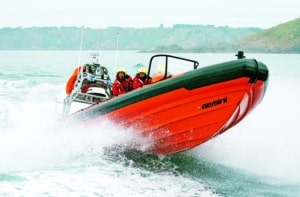
- Twin 225 Mercury V6 Verado engines
- Twin 300L fuel tanks
- 300L water ballast system
- 1 x 12in Raymarine Axiom
- 1 x 9in Raymarine Axiom
- Raymarine Quantum 2 wireless chirp radar with Doppler collision avoidance
- Raymarine bullet FLIR camera
- Icom M506-GE VHF
- AR200 Augmented Reality (consisting of a Global Navigation Satellite System (GNSS) receiver and an Attitude and Heading Reference System (AHRS) sensor) The AR200 provides position, heading, pitch and roll data to a compatible Axiom MFD Diamond Wireless Communication System
- Rhotheta RT-300 direction finder (combines a communication direction finder with an MOB direction finder)
- Fuel vapour alarms
- Fixed and hand-held searchlights
- Salvage pump
- Anchor and tow reel
- Commercial stern arch/A-frame with self-righting system
- Allsalt SHOXS shock mitigation jockey seats
The story behind the name
The exercise I joined was being conducted under the direction of JLA coxswain Andy Hibbs, a veteran lifeboatman of huge repute in Jersey. This commercial fisherman has spent decades saving lives around Jersey and was previously the RNLI coxswain of Jersey’s all-weather lifeboat. In fact, the creation of the JLA can largely be traced back to events from 2017 involving Mr Hibbs. One morning that April, stood shoulder to shoulder along St Helier’s Albert Pier in the glorious spring sunshine, was a crowd of over a hundred people. As the boats moored in St Helier Marina gleamed under a clear blue sky, speeches were made to the crowd. Local and national media filmed and photographed as ranks of RNLI crewmen stood next to the lifeboat station having stood down en masse in solidarity.
This extraordinary situation followed the sacking by the RNLI of Mr Hibbs. After his departure, over two dozen local volunteer crew had stood down to protest the sacking and show their support for Mr Hibbs. Just two months later, this schism had appeared to have reached a resolution when it was announced that he had been reinstated and a spokesman for the RNLI said the organisation ‘had not met the high standards of support and fairness’ they should have given to Mr Hibbs. The charity announced that it ‘would work with Jersey emergency services to restore a safe, effective and inclusive local volunteer lifeboat service’.
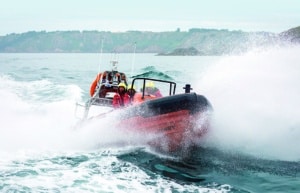 In November 2017, Jersey’s marine community was once again rocked to its core when an announcement was made that the main RNLI lifeboat station in St Helier was to be shut, and the island’s Tamar-class all-weather lifeboat George Sullivan was on its way back to Poole having been ordered there by RNLI headquarters – something that caused a great deal of anger locally. It was viewed by many as a betrayal, not least because the vessel had been acquired following an appeal for funds locally that raised £1.33 million.
In November 2017, Jersey’s marine community was once again rocked to its core when an announcement was made that the main RNLI lifeboat station in St Helier was to be shut, and the island’s Tamar-class all-weather lifeboat George Sullivan was on its way back to Poole having been ordered there by RNLI headquarters – something that caused a great deal of anger locally. It was viewed by many as a betrayal, not least because the vessel had been acquired following an appeal for funds locally that raised £1.33 million.
The JLA was subsequently formed by Andy Hibbs and a number of former RNLI crew who had left the service in solidarity upon their cox’s dismissal in 2017. Shortly after its formation, the JLA secured a former Tyne-class RNLI all-weather lifeboat named Sir Max Aitken III and this vessel has been a declared Jersey SAR asset since 11th April 2019. In November 2020, the JLA then announced that sufficient local donations would permit the acquisition of an inshore lifeboat and that this would be a Gemini fitted out by Berthon in Poole at a cost of approximately a quarter of a million pounds.
This new vessel arrived in Jersey from the UK on 4th July 2021 having been delivered by the crew themselves. Following the usual process of the vessel being surveyed and then declared formally as an official SAR asset, Jersey is now served by two all-weather lifeboats – and three inshore lifeboats when one includes the two Atlantic 85s belonging to the RNLI. Thus far, the JLA has responded to 39 calls and logged over 76 hours out on shouts. New volunteers are joining all the time, augmenting its core of RNLI veterans.
While its genesis lay in conflict, the Jersey Lifeboat Association has become a greatly admired part of Jersey’s search and rescue community, which is one positive aspect to the events dating back to 2017. Just a few short months after its formation, the organisation’s dedicated volunteer base was on its way to raising sufficient funds to equip the crew and set up a new lifeboat station on St Helier’s Albert Pier and acquire an all-weather lifeboat and now this new thoroughbred from Gemini. As a result of its dedication and the obvious commitment of its crew, lives have already been, and will continue to be, saved. As the JLA trains new helmsmen to take the Albert Pinel out into harm’s way to protect others, I’m in no doubt following my short time on her that she will serve them faithfully.
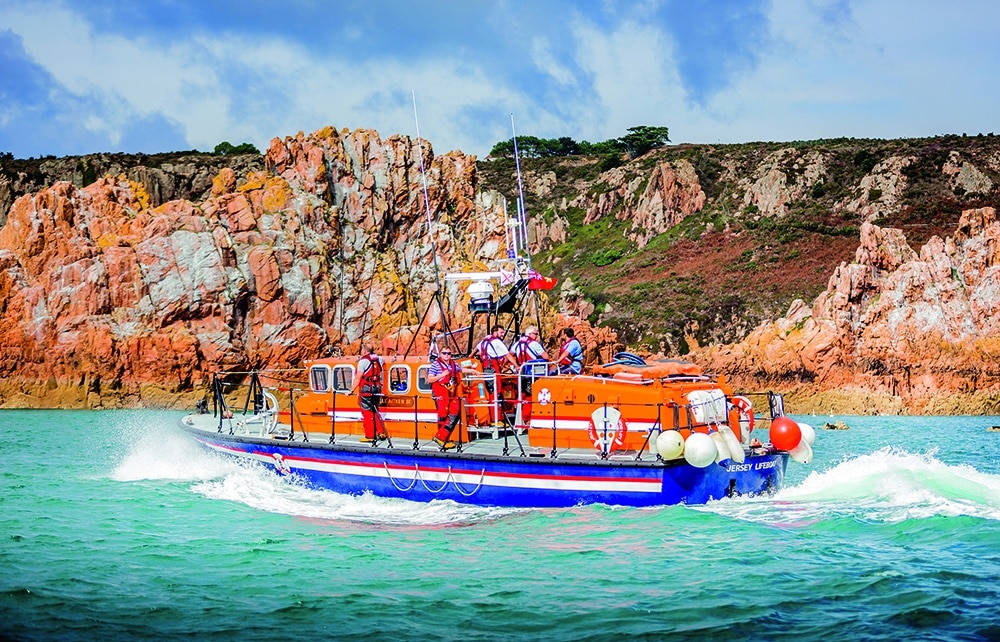 Jersey’s Tyne Class Lifeboat, Sir Max Aitken III, is an all-weather class of vessel with a famed pedigree of service. 40 or so were originally built by the RNLI with the very last Tyne being withdrawn from service with the Institute in 2019 upon being superseded by the Tamar Class.. The unusual design of this lifeboat derives from the requirement to deploy from slipway stations built for previous generations of lifeboats, with limited clearance. The Tyne also lies afloat at stations where the approaches, or operating areas, are particularly shallow. As the lifeboat’s propellers are protected by heavy bilge keels, she is particularly well suited to operate where there is a danger of grounding. The Tyne has a steel hull and aluminium superstructure. The first two were powered by General Motors 8V-71 diesels of 425 bhp, but the production boats switched to the newer GM 6V-92 of the same power. During the course of production, the weight of the boats increased by over 1 ton; this required an increase in superstructure volume to preserve the self-righting capability, resulting in the height of the aft cabin being raised. Later, further doubts about the self-righting capability resulted in air bags being added to the aft cabin roof.
Jersey’s Tyne Class Lifeboat, Sir Max Aitken III, is an all-weather class of vessel with a famed pedigree of service. 40 or so were originally built by the RNLI with the very last Tyne being withdrawn from service with the Institute in 2019 upon being superseded by the Tamar Class.. The unusual design of this lifeboat derives from the requirement to deploy from slipway stations built for previous generations of lifeboats, with limited clearance. The Tyne also lies afloat at stations where the approaches, or operating areas, are particularly shallow. As the lifeboat’s propellers are protected by heavy bilge keels, she is particularly well suited to operate where there is a danger of grounding. The Tyne has a steel hull and aluminium superstructure. The first two were powered by General Motors 8V-71 diesels of 425 bhp, but the production boats switched to the newer GM 6V-92 of the same power. During the course of production, the weight of the boats increased by over 1 ton; this required an increase in superstructure volume to preserve the self-righting capability, resulting in the height of the aft cabin being raised. Later, further doubts about the self-righting capability resulted in air bags being added to the aft cabin roof.

